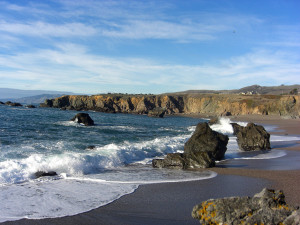Thecash-strapped city of Benicia has come up with a novel way to keepits state recreation area open and off the list of California parkclosures: get the state to foot the bill. Or at least ask.
Thesmall, waterfront community in Solano County decided it couldn’tsit back and watch the 500-acre Benicia State Recreation Area shutterin July. While not as well-known as many of the other 14 BayArea state parks slated for closure, it is heavily used by the localcommunity, and is the only outdoor state park in the county. So thecity and some of its residents are proposing to keep the gates openby asking the state to pick up an $80,000 tab for the city’smaintenance and operation costs. That’s less than half the state’sbudget to run the park.
“Wedon’t have the funding to take on the whole operation,” said MikeDotson, director of Benicia’s municipal parks. “That’s why wehave this creative approach.”
The state describedthe plan differently. “If we had the money tooperate the park we would keep it open ourselves,” said State ParksDepartment Spokesman Roy Stearns. “The whole goal here is to findpartners who can provide the funding to keep the parks open.”
Asa July 1 deadline looms on nearly 70 California state park closures,park advocates around the state are scrambling to come up with waysto keep their favorite natural spots open, often through theestablishment of a nonprofit organization that can fundraise andshoulder caretaker duties. Other parks have seen an outpouring ofmonetary support: Supporters of Henry W. Coe State Park near MorganHill raised $1.2 million with the bulk coming from one Silicon Valleyentrepreneur. But not all parks – Benicia included –have accessto such deep pockets.
Nevertheless,city officials and the Benicia State Parks Association, a nonprofitgroup run by residents, felt that the recreation area, as well as theBenicia Capitol State Historic Site in the center of town (also onthe closure list) were too critical to let go.
Dotsonsaid he hasn’t come across such a proposal before, and is having totweak a state template for an operating agreement to allow for theunusual arrangement. Whether the state will go for it is an openquestion. It certainly seems odd to charge the state to operate apark it says it can’t afford to keep open. And it’s not clear that the city has an alternate plan if the state turns down the proposal.
Thecity’s plight has drawn the attention of Rob Hanna, who wasinstrumental in the successful battle to take Mono Lake off the stateclosure list. Hanna also happens to be the great-great grandson oflegendary naturalist John Muir.
“Ourparks deserve better,” said Hanna during a December visit to thepark. “The message is – we’re going to fight. We owe it to thepark.”
The recreation area, andthe town itself, are situated on the surging waters of the CarquinezStrait, where the Sacramento River meets San Francisco Bay. Marshlandalong the park is home to at least two endangered species, theCalifornia clapper rail and northern salt marsh harvest mouse. Therecreation area’s tip at Dillon Point is the narrowest spot in theSan Francisco Bay.
“The staterecreation area is used by a lot of residents,” said Dotson. “Andthe old Capitol downtown impacts the downtown area from an aestheticstandpoint.”
Benicia officialssay they can run the recreation area at less than half the state’s$200,000 yearly budget by relying on a combination of city staff andassociation-led volunteers to do maintenance and patrols.
“Oneof the issues we have at the state recreation area is that someonehas to lock and unlock the gate each day,” said Bob Berman of theBenicia State Parks Association. “It’s an issue for the statefolks. Someone has to drive to Petaluma and back. It’s crazy.”
Atleast one other city in California has come to a similar conclusion.The city of Colusa struck and agreement with the state to take over and operate the ColusaSacramento River State Recreation Area for $44,000, a fraction of thestate’s $212,000 annual budget. In that case, however, Colusa isfunding the maintenance work itself.
Beniciais proposing to hire four seasonal workers and use city staff tomanage the gate to vehicular traffic, maintain restrooms and trails,and do the grounds keeping. The parks association is hoping toassemble volunteers to serve as volunteer park rangers in the vein ofa Neighborhood Watch-style program to report vandalism and othercrimes. The park has become a target for copper wire theft.
Asa separate agreement, Benicia is kicking in $25,500 torun the historic site, which features the oldest remaining Californiastate capitol building. The parks association would be in charge ofthe neighboring historic Fischer-Hanlon House. Both parties hope tofind ways to cover those costs without dipping into city coffers andare considering possible parking and use fees, or hiring the sitesout for promotional photography or movie sets.
Oneaspect of the two parks that Benicia and the association are adamantabout not taking over are the state’s deferred maintenanceresponsibilities, which add up to $3.5 million in leaky roofs,failing septic tanks, a deteriorating building foundation, andmore.
In February, the city plansto submit the proposal for a two-year operating agreement. Bermansaid it’s probably overly optimistic to expect the state to get outof its budget morass in that short amount of time. On the other hand,he said he doesn’t want the locals to be in charge for the longterm. Volunteers and fundraising can easily dry up, he said.
“Oneof the things we’re concerned about is if we start doing a good jobrunning these parks, there’s not going to be much of an incentivefor the state to come back,” Berman said. “We’re concernedbecause we can’t take this on forever.”
Eric Galan contributed to this story.

.jpg)



